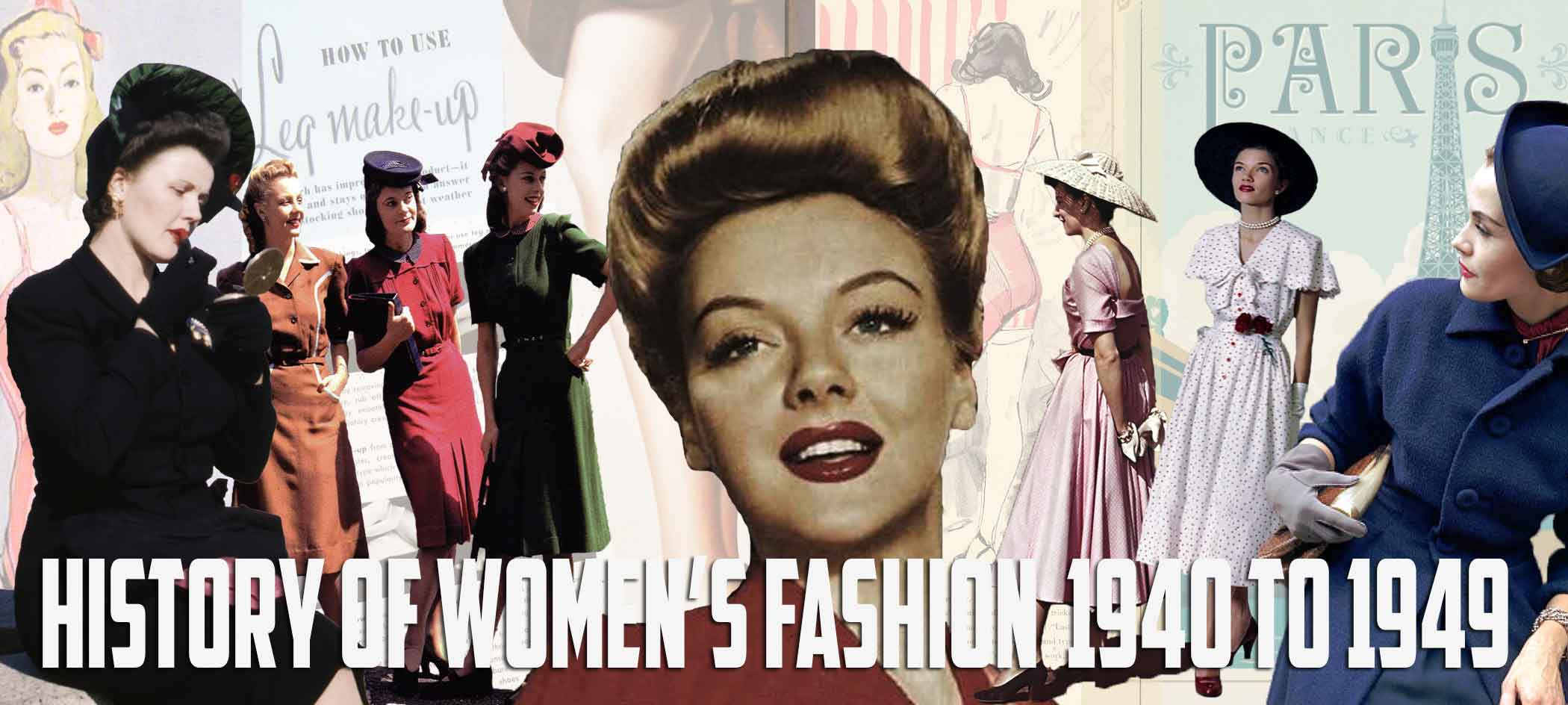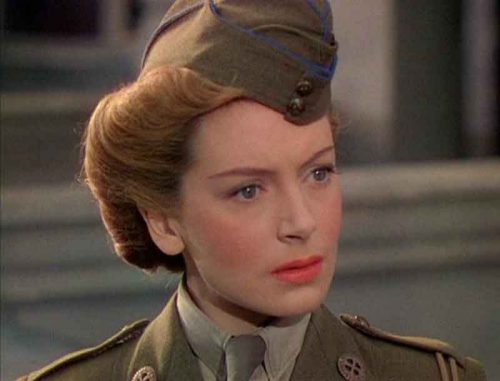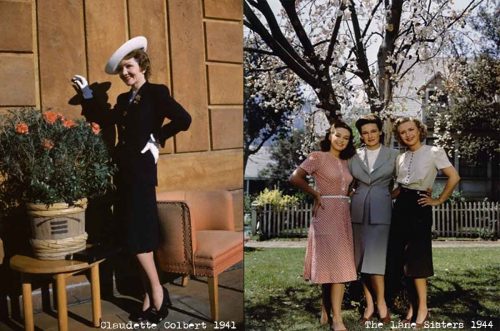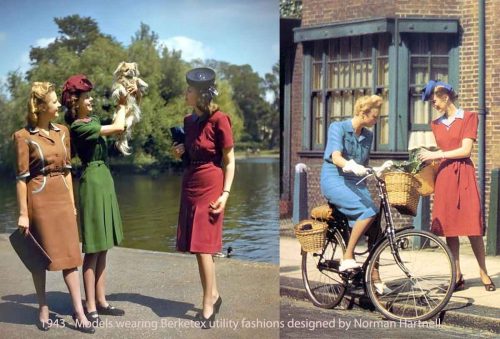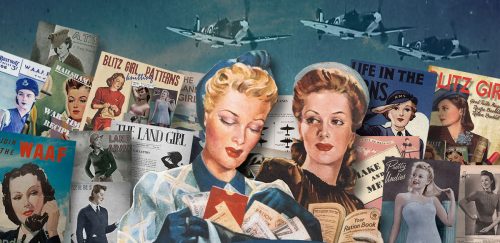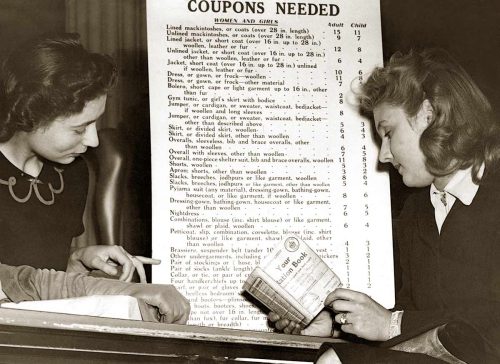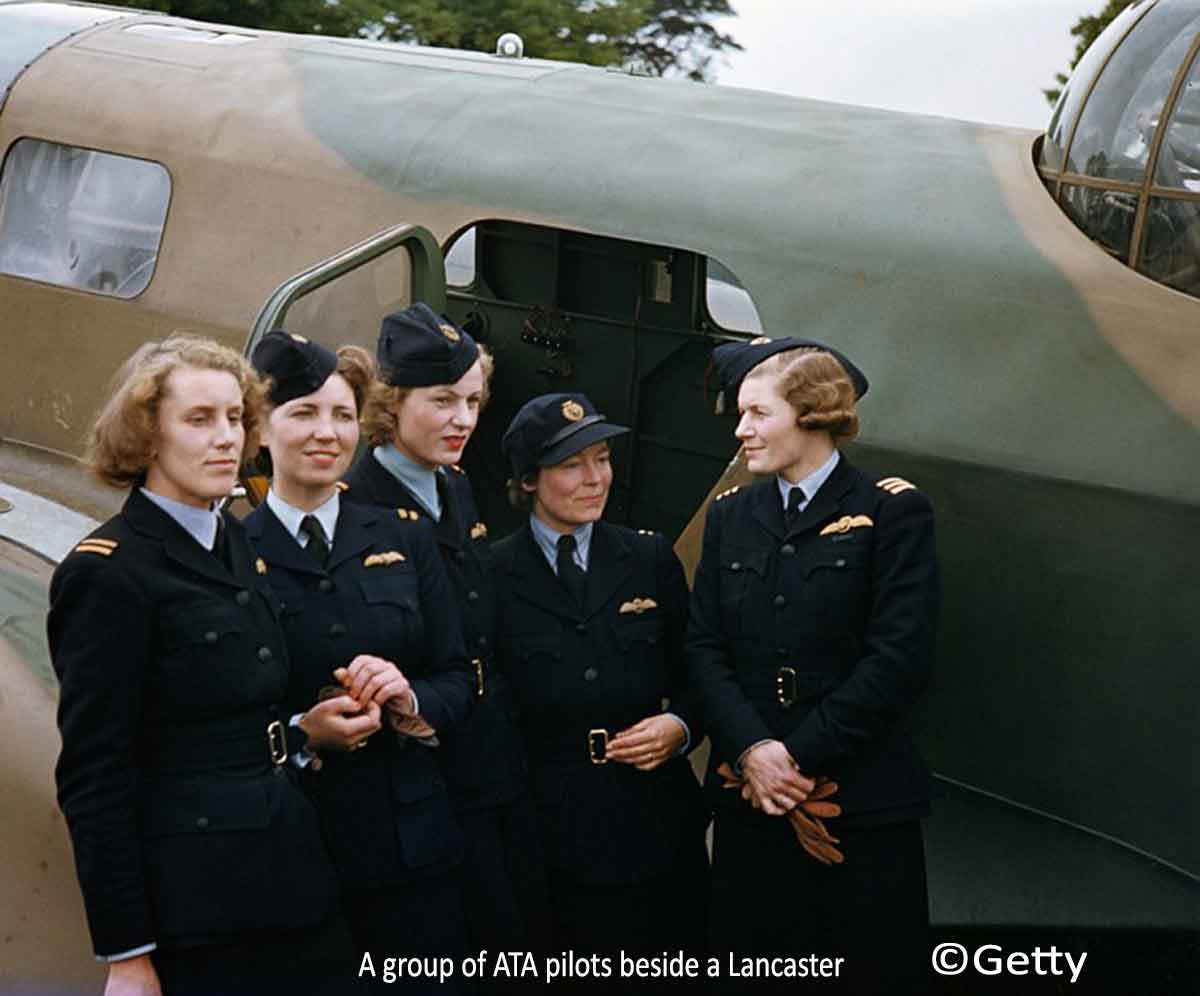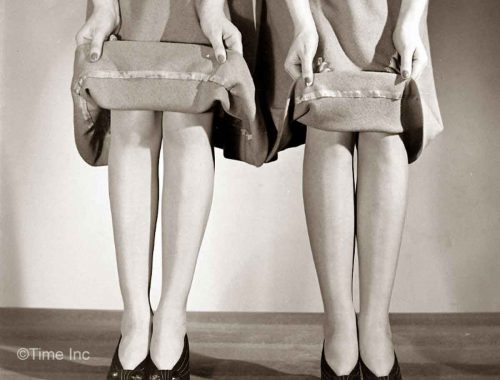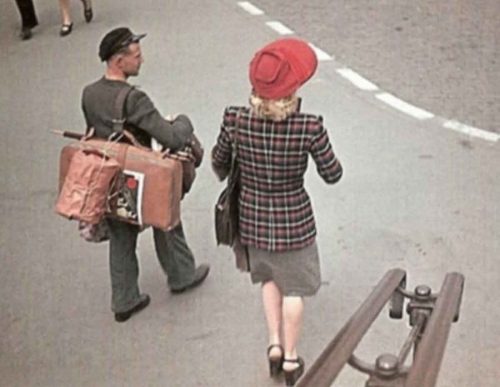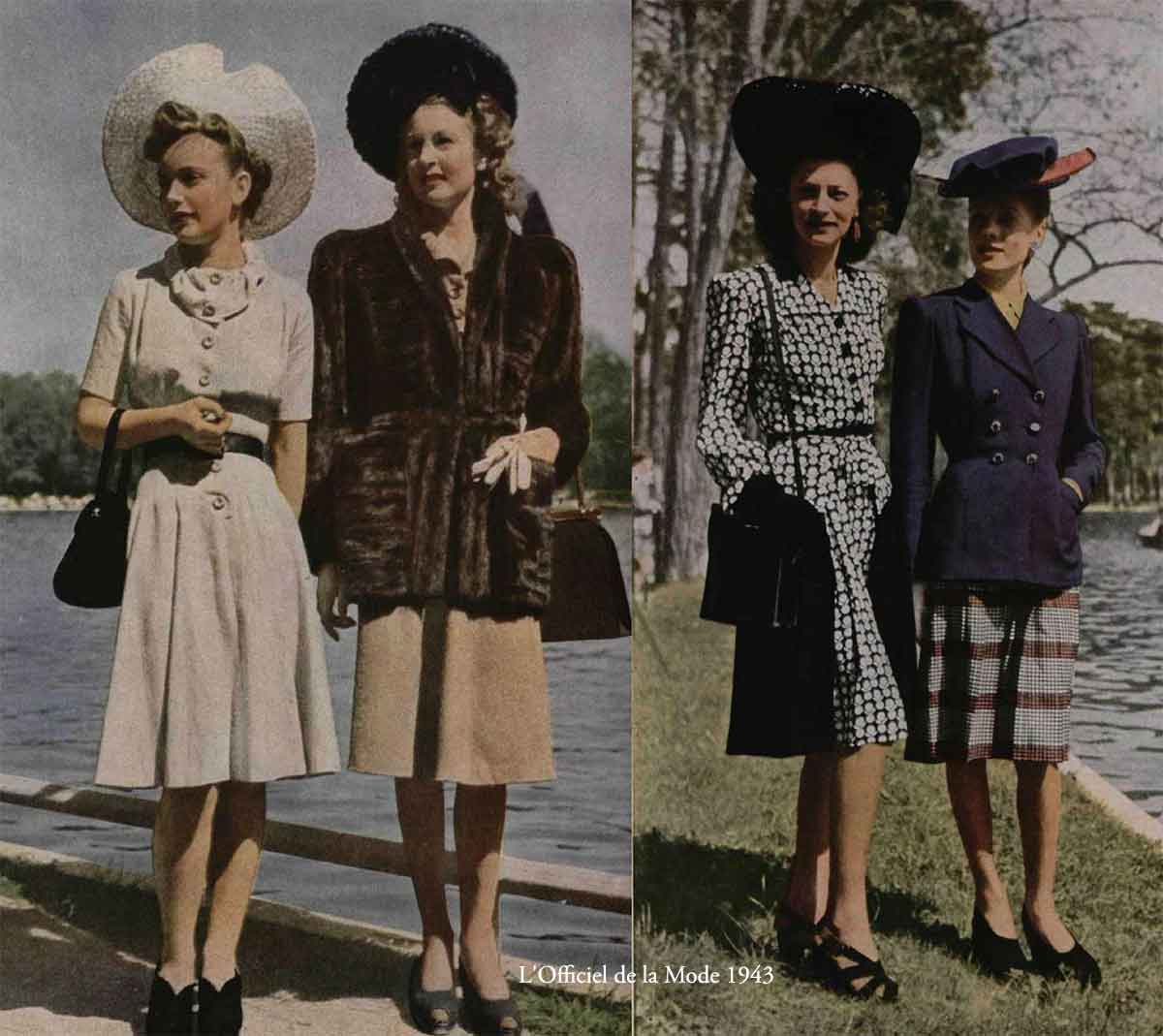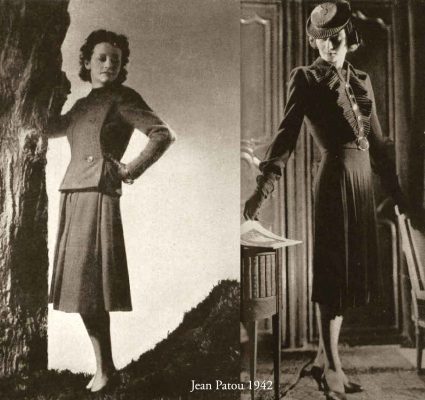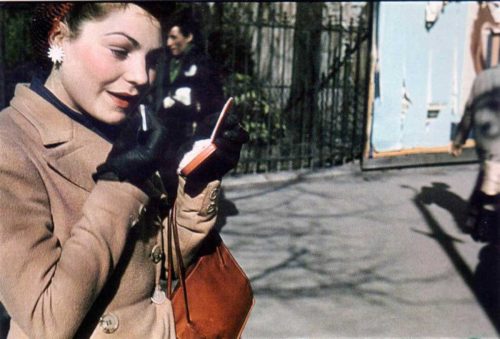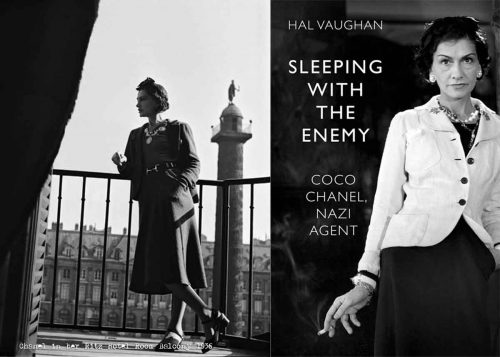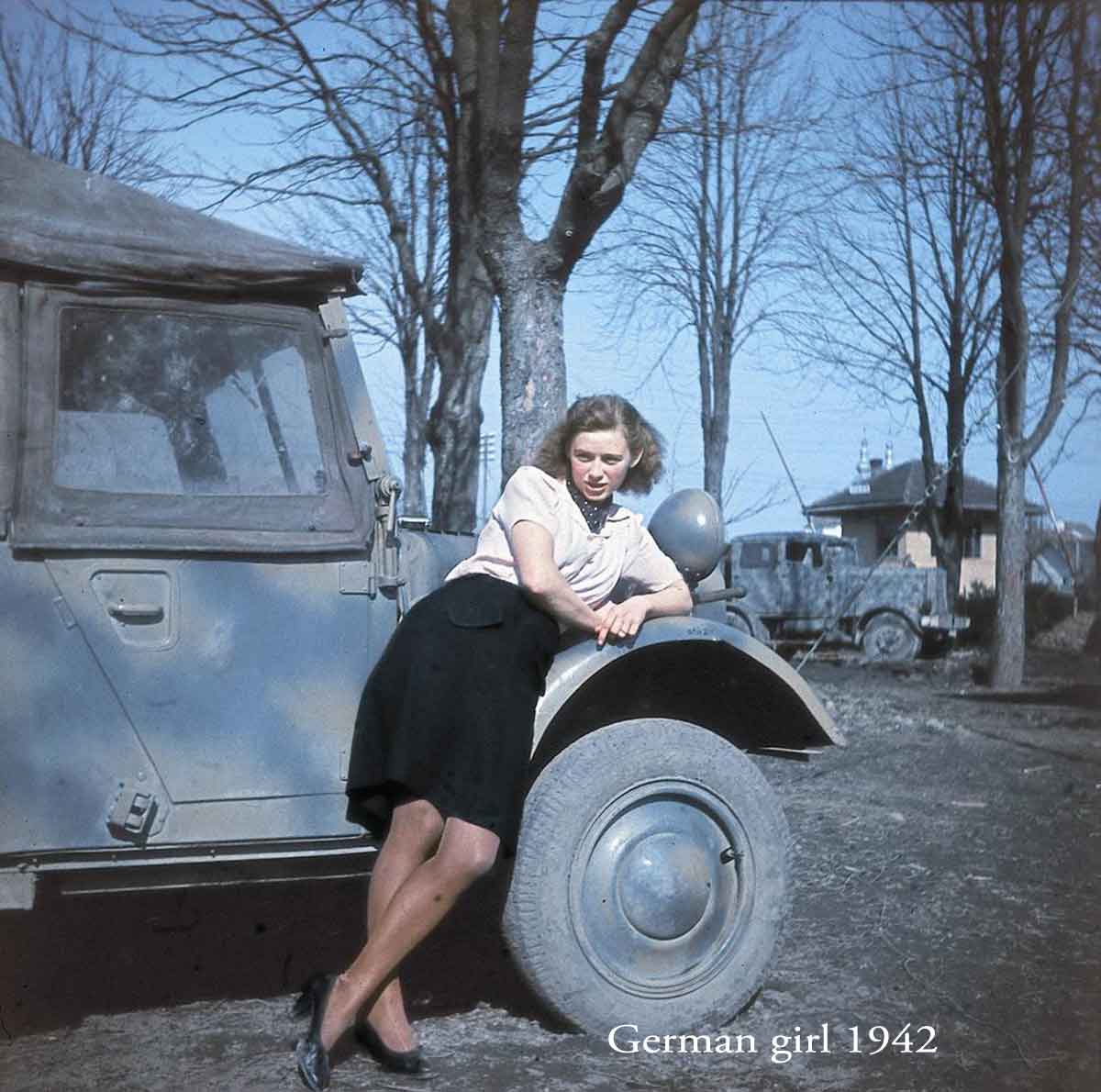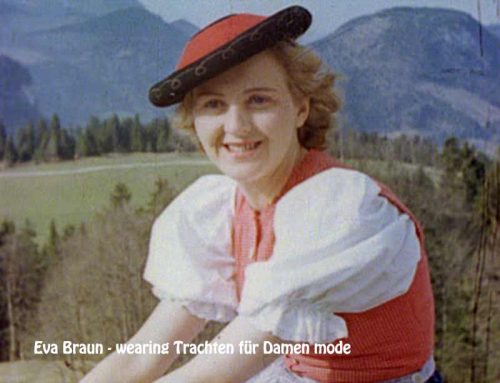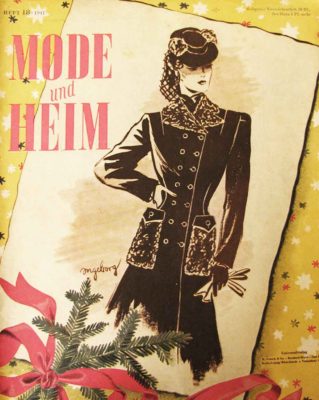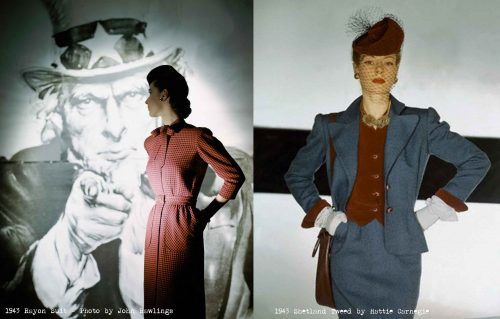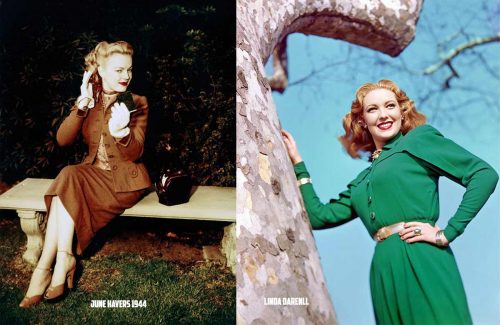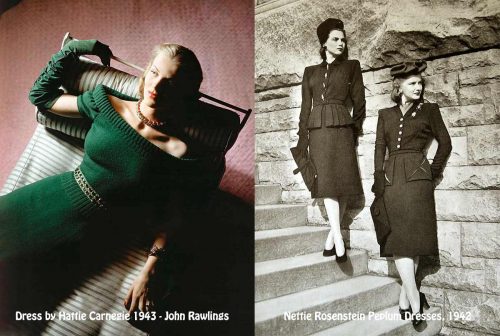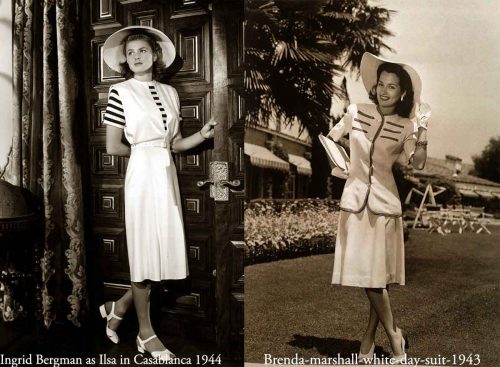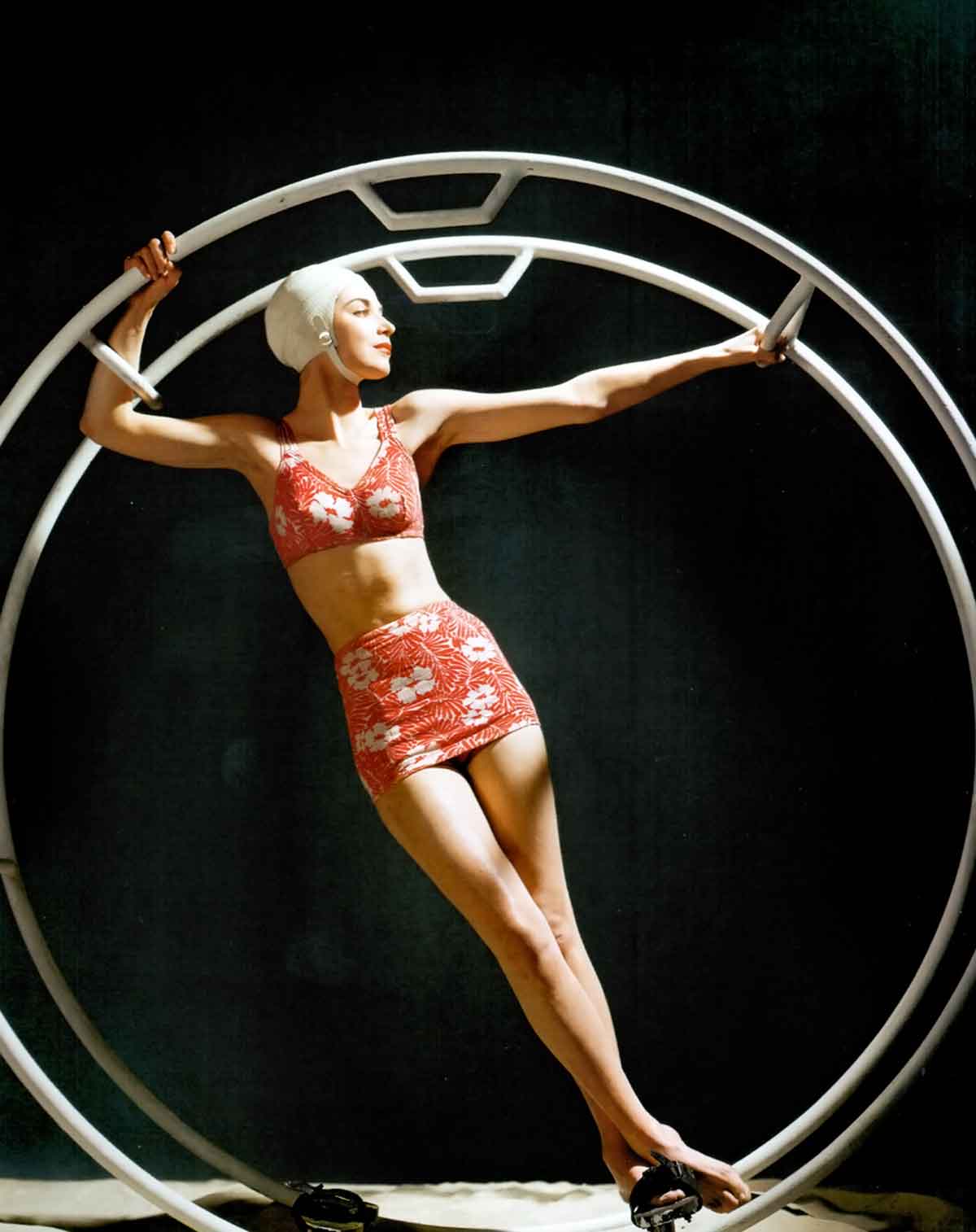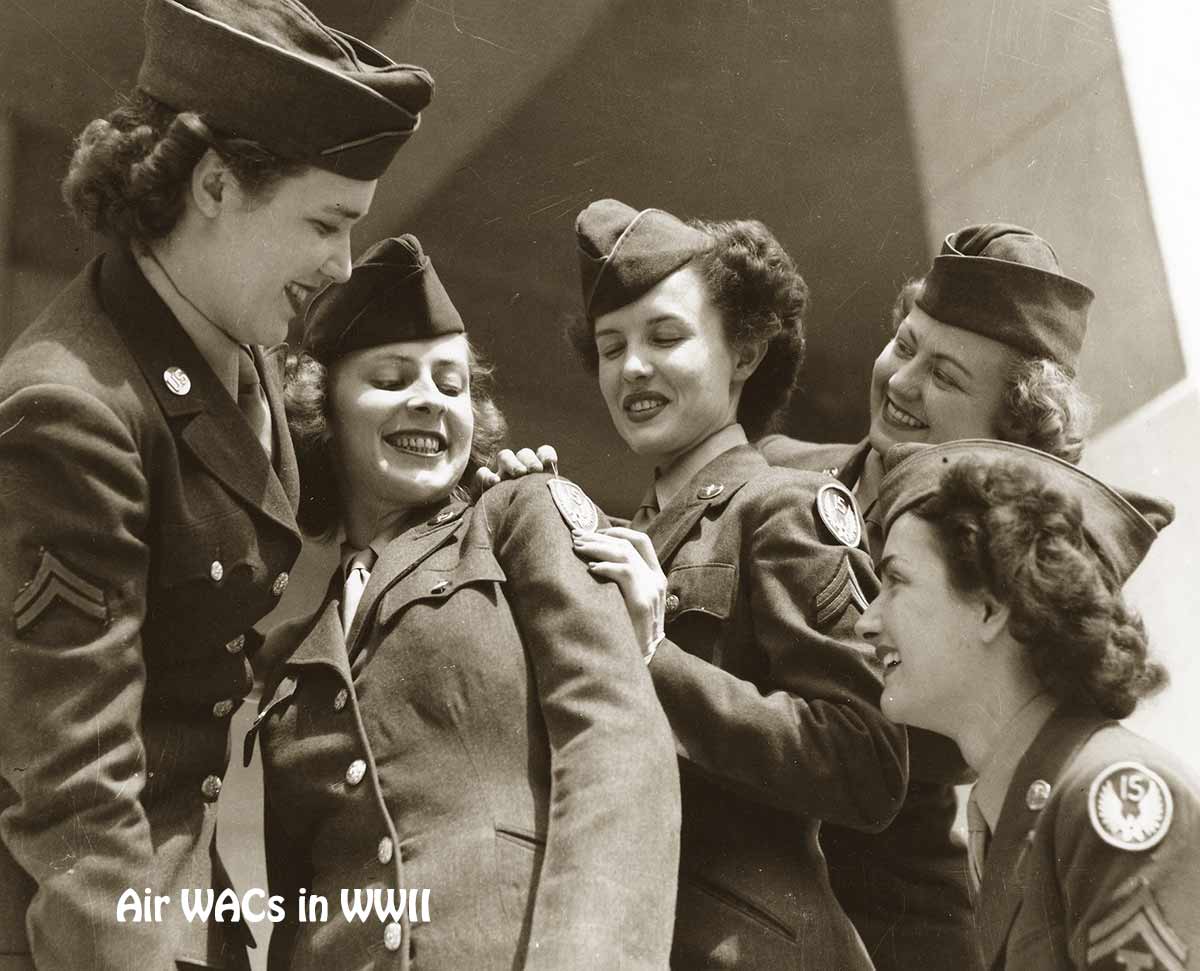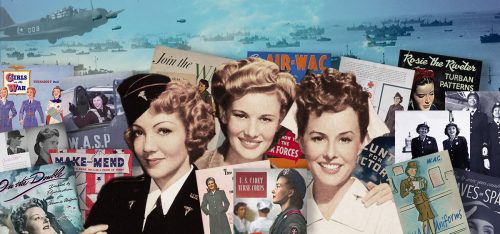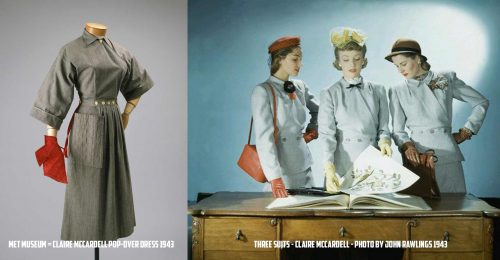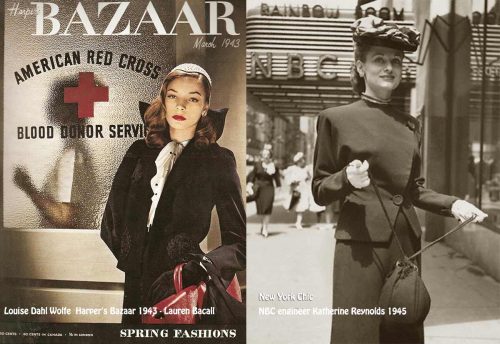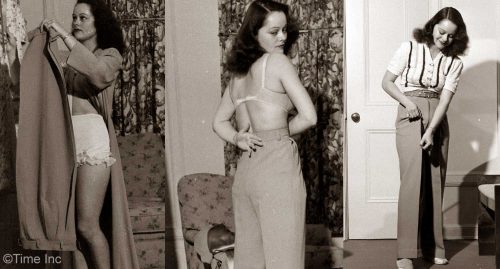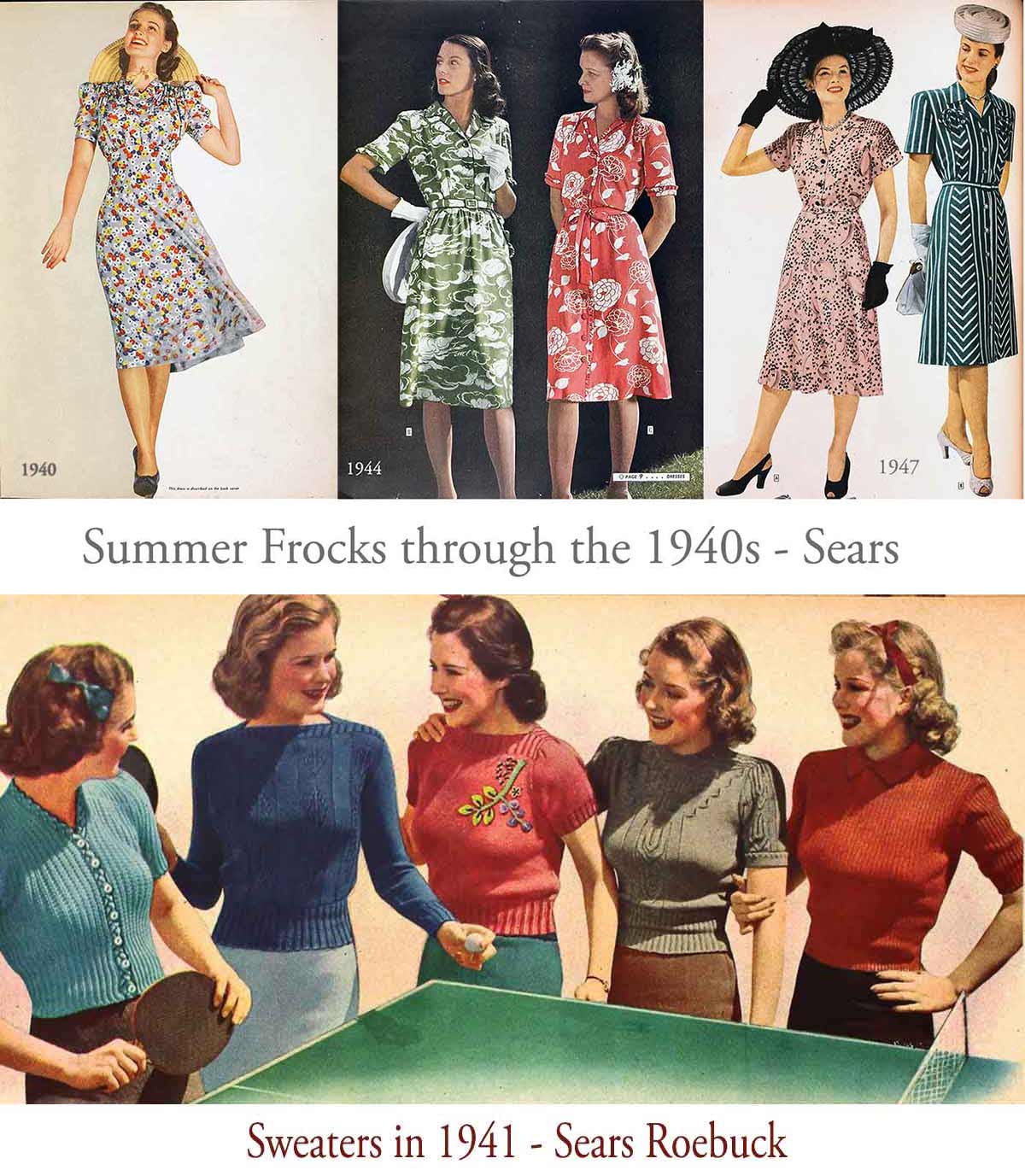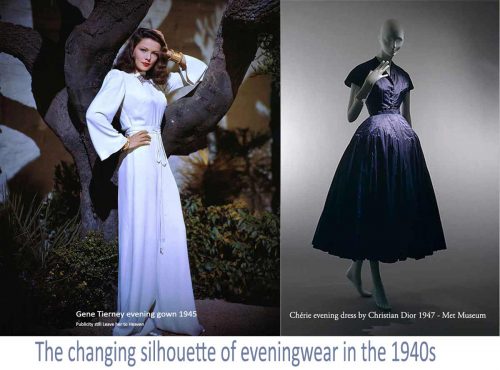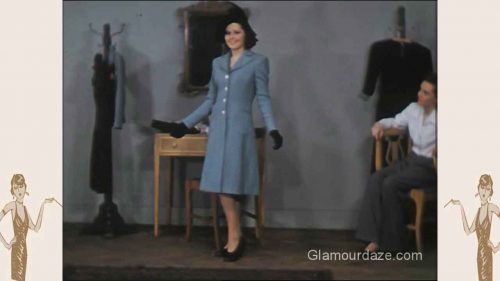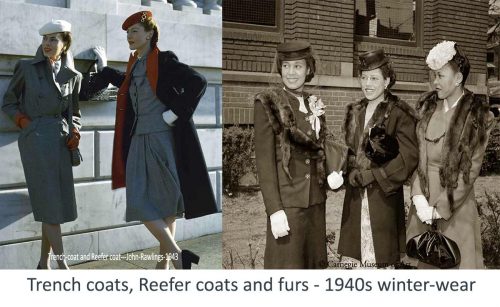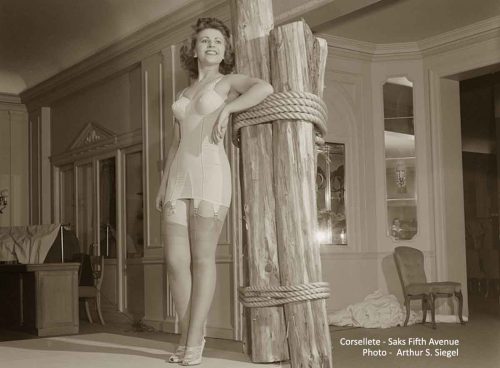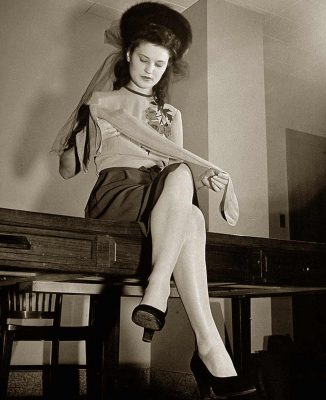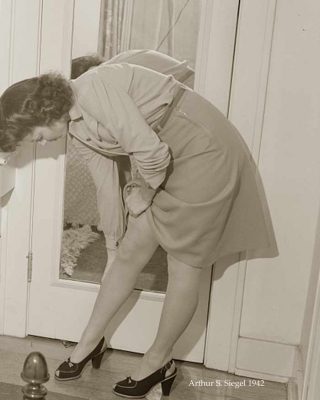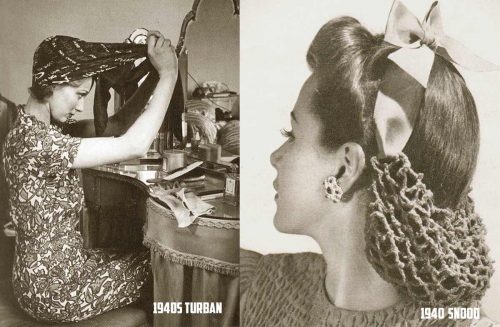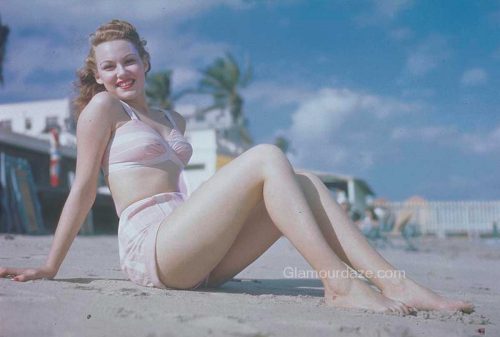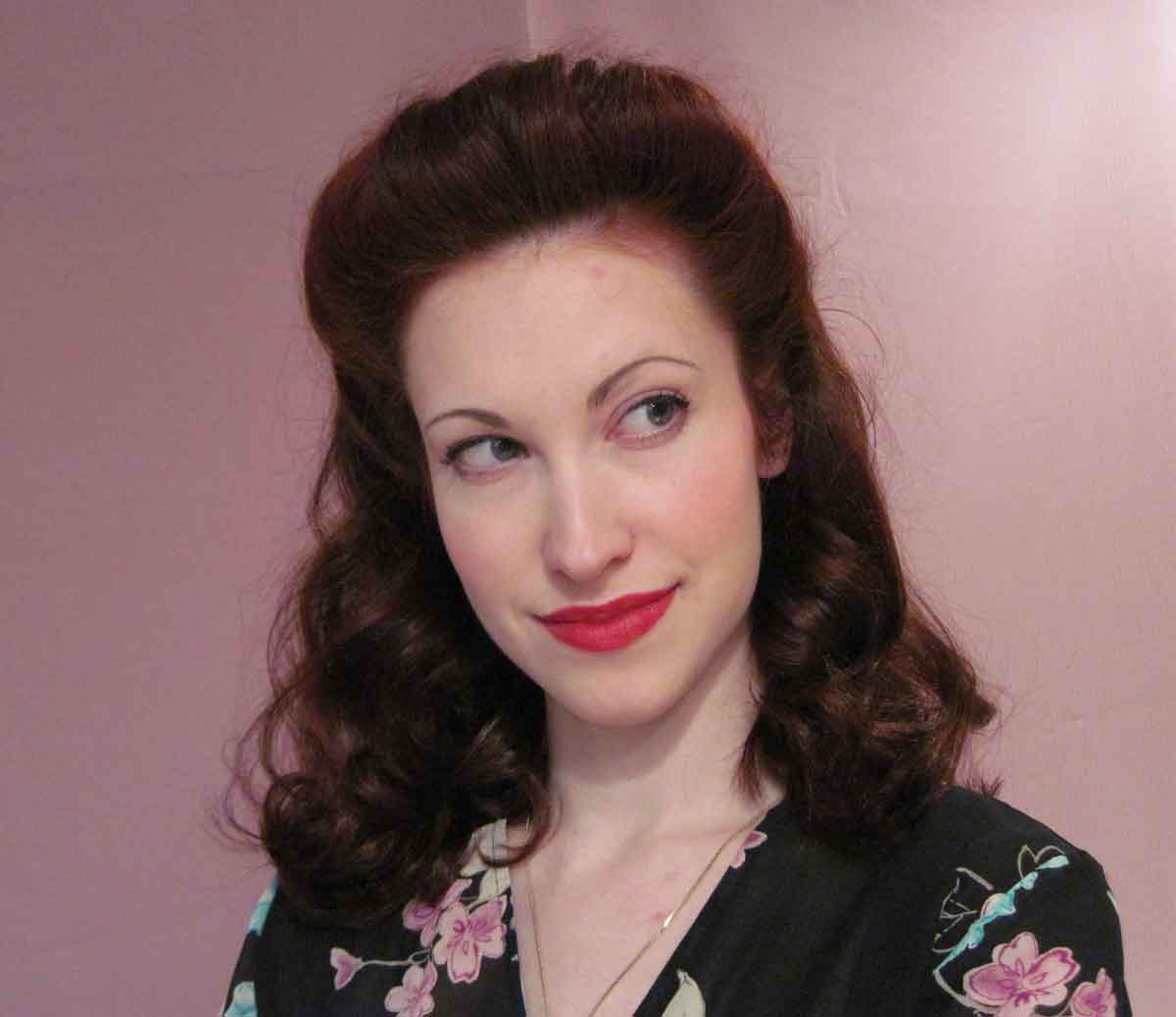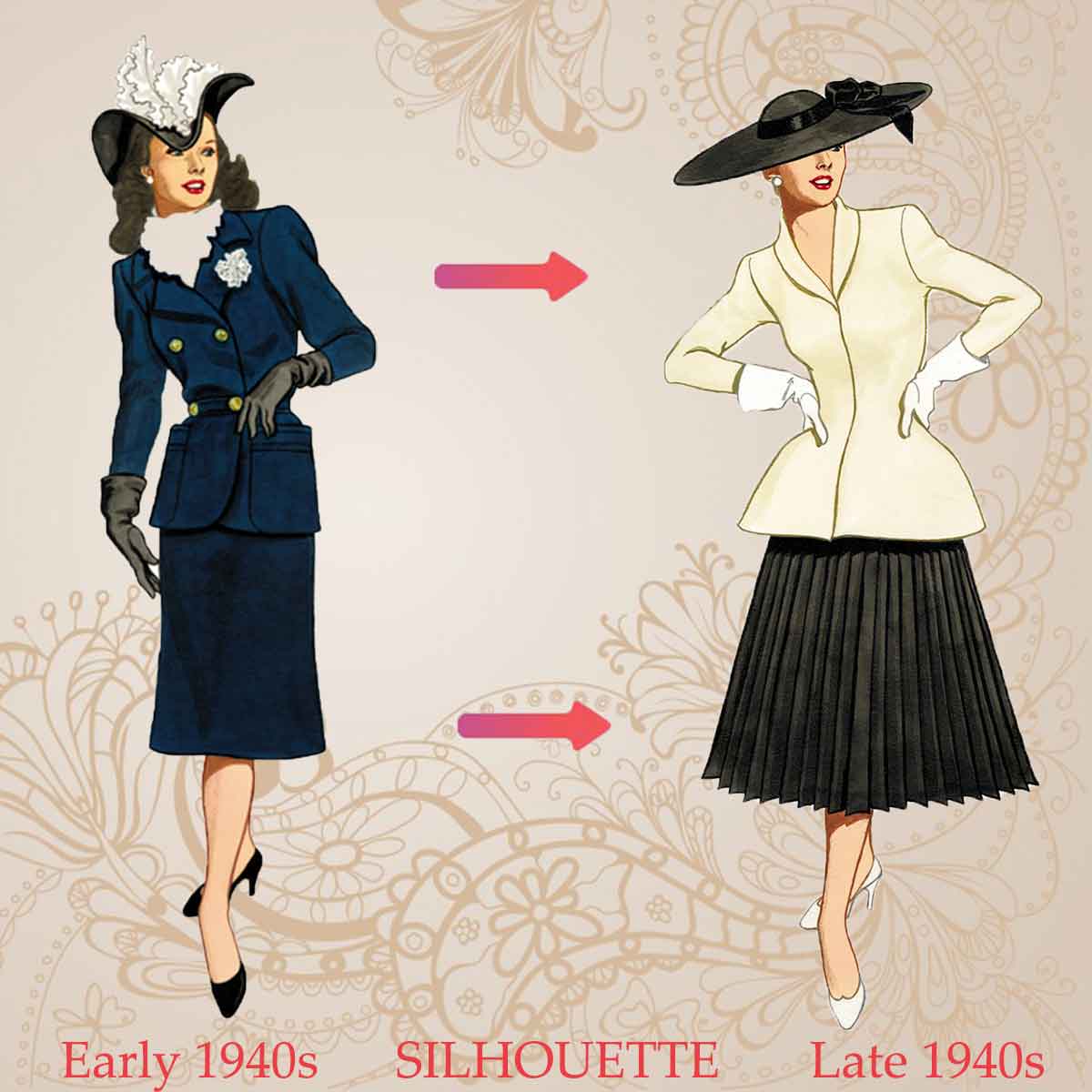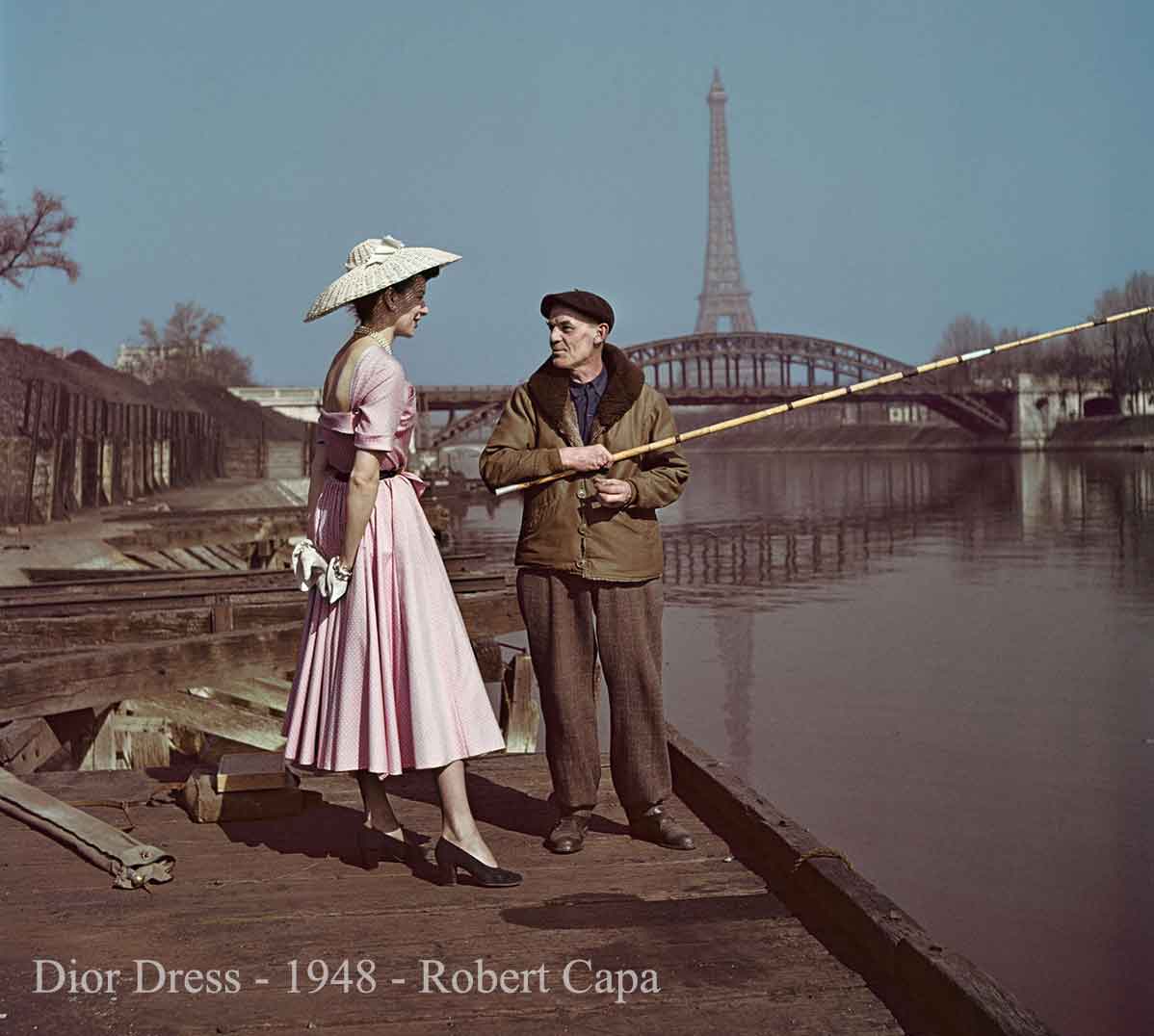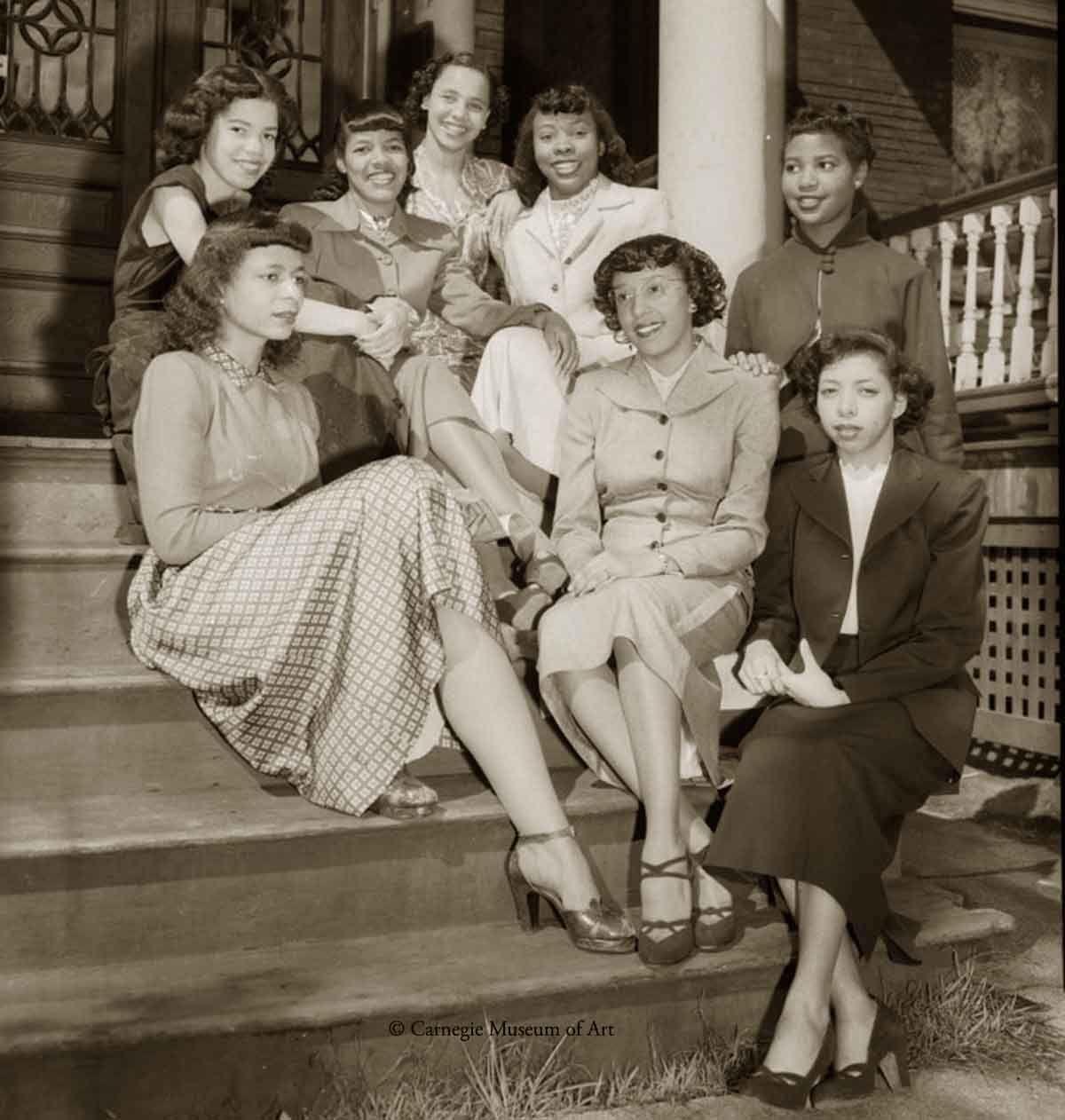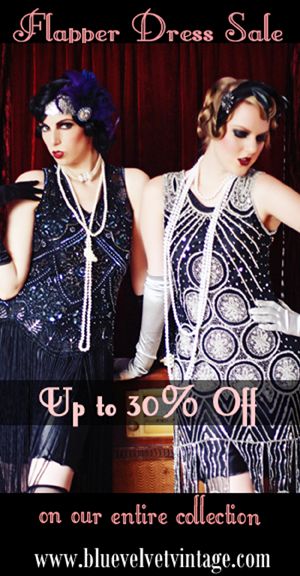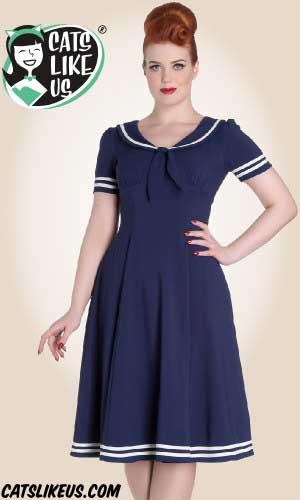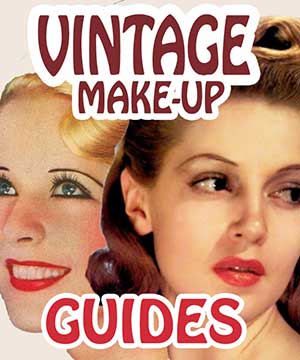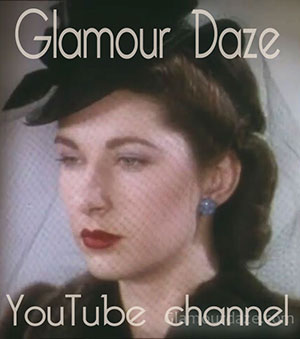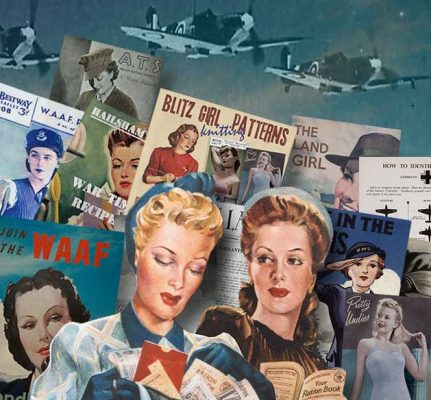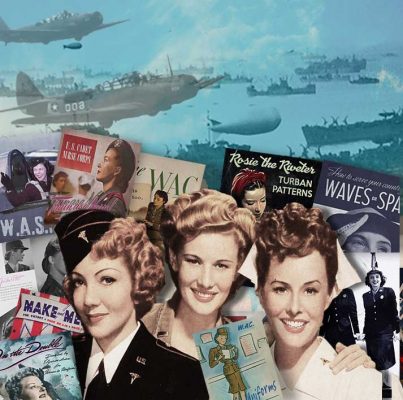Brief History of Women’s Fashion – The 1940s –
A concise illustrated history of Women’s Fashion and Style – 1940 to 1949.
Introduction
1.1940’s Style – The key Features
2.Fashion during the War – 1939 to 1945
a.Utility Clothing
b.US War Restrictions on clothing
c.Paris Fashion under Nazi Occupation
d.German Fashion under the Nazis
e.Paris Loses Supremacy to the American Look
3. Daywear
4. Eveningwear
5. Outerwear
6. Underwear
7. Accessories
a.Hosiery
b.Shoes
c.Hats
d.Swimwear
e.Makeup and War
8. 1940s Hairstyles
9. The Post War Silhouette
Introduction

Casablanca – Rick and Ilsa
Ilsa: I wasn’t sure you were the same. Let’s see, the last time we met was…
Rick: La Belle Aurore…Paris. I remember every detail. The Germans wore grey, you wore blue.
Ilsa: Yes. I put that dress away. When the Germans march out, I’ll wear it again.
Ingrid Bergman and Humphrey Bogart – Casablanca 1942
When the history of a conflict is usually written, there is scant attention given to such supposedly “frivolous” matters as women’s fashion. But the Second World War had such a seismic impact on humanity, that we do history a disservice to exclude fashions significance, and in particular that of women’s fashion. I would contend that fashion is the absolute expression of a generations life experience.
We perceive the past visually, and women’s style of the early 1940’s gives us as much insight into the period, as any visit to a military museum. The First World War blew away the corsets, and the more military influenced styles paved the way for the gamine look of the 1920’s. The 1940’s war era woman is preserved endlessly on screen.
From the iconic femme fatale portrayed by Barbara Stanwyck (Double Indemnity 1944) or the brave and beautiful Lauren Bacall (To Have and have Not 1944) to Deborah Kerr‘s chirpy MTC driver in Life & Death of Colonel Blimp 1943).
The 1940’s saw a major shift in fashion, perhaps not as seismic as that which followed WW1, but a significant change nonetheless from a tailored but inventive make-do and mending in the first half of the decade, to a renaissance in women’s style in the second half, that both celebrated the romantic styles of the past and embraced a forward thinking philosophy of a confident modern and glamorous woman.
1.1940’s Style – The key Features
1.Utility clothing: tax free basic all day suits dictated by official fabric restrictions.
2.Pants: now a socially accepted alternative to skirts.
3.Bolero jacket: padded shouldering and slim waist emphasis. A very popular style feature of the 1940s.
4. Peplum jacket: over skirt attached to boxy jackets or blouses.
5.The shirtwaist dress; tailored collar and defined waist.
6.The Trench Coat – a military influenced style.
7. The Dirndl skirt.
8. Bullet Brassieres.
9.The Pompadour hairstyle.
10. Seamed hosiery.
11.Sportswear – play-suits and swimsuits.
12.1947 New Look.
2. Fashion during the War – 1939 to 1945
At the outbreak of war, Paris was still the undisputed leader of world fashion. The commercial buyers headed as usual to the Parisian Autumn Haute Couture collections. The collections that year reflected the reality of what was to come, with women’s day wear looking more and more ‘masculine’ and tailored. The whimsical broad shouldered suits of 1938 now became boxy and military. Luxury evening wear was produced more for the American buyers, rather than for European.
For a while, London and Paris designers were falling over themselves to come up with clever clothes for ‘women at war’, the garment names even hinting at exciting times ahead – ‘shelter pyjamas‘, ‘siren suits‘ and so on. Even a handbag which converted into a gas mask! However the horrible reality of war put a stop to frivolity. The 1940 Paris autumn collections were completed just before the German occupying forces swept their way into Paris that June.
Despite the Unites States entry into war in 1941, the fashion industry flourished with the help of Hollywood, and while Paris’s star was fading under fascist occupation, American fashion became the prominent player during the war years.
During the early war years of the 1940’s, women’s wardrobes were thus kept to a minimum, with an emphasis on frugality and versatility. Looking at wedding photos of that period, they were simple affairs, very often with the bridesmaids in uniform. It was the utility clothing era, the ‘make-do-and-mend’ era, when a woman’s style was hindered by budget and rationing. In England, some interesting novelties appeared such as luminous buttons for blackout conditions.
The luxury synthetic Nylon, introduced in May 1940 had revolutionised women’s clothing and in particular, hosiery, only to be diverted to war production and labelled a luxury. A pair of nylons were a sure way to a young British or French girls heart and in 1944 American servicemen arrived with kit bags copiously filled with them.
Utility Clothing
In Britain during the 1914 – 1918 war, the rationing of commodities including clothing, brought about the idea and subsequent late introduction of “standard clothing” in 1917. It was dropped shortly after the war ended as imports and manufacturing returned to normal.

Perhaps anticipating a long conflict, in 1941, the Board of Trade introduced the CC41 label ( or ‘controlled commodity’ but generally referred to as “civilian clothing”). Any clothing bearing the CC41 logo was tax free and made primarily from cotton and wool.
In 1942 the Incorporated Society of London Fashion Designers or Inc.Soc comprising some of Britain’s notable designers such as Edward Molyneux, Norman Hartnell, Hardy Amies, Victor Stiebel and Elspeth Champcommunal submitted thirty-two designs which were modelled by volunteering female war-workers. The previous year a promotional film shot in lavish colour by Jack Cardiff showcased many styles in cotton by these top designers.
Learn how the iconic Blitz Girls lived, the units they served in, the fashions they wore, the hair and beauty rules they followed, and so much more. You can download these 1940s British Wartime Women Packs all direct to your device !
From Coupons to Couture
The designs received such praise in Vogue that soon women were snapping up the colourful dresses. Described by Vogue as “serenely perfect”, this shift to CC41 clothing restrictions was done with such style by Hartnell and Co, that they inadvertently introduced designer fashion to British high streets.
“The utility brand was a sartorial success,” says historian Julie Summers,“the government was convinced fashion could help win the war – by keeping morale up on the Home Front.”

Also it was thought that with Paris couture under constant threat of being moved to Berlin, this was London’s chance to become Europe’s new fashion capital.
As the war deepened, constrictions on fabric forced the Board of Trade to impose severe austerity in what was allowable in design. Non essentials included the amount of pleats on a skirt, as well as limitations on the amount of buttons, seams and ruching.

Using her annual allocation of sixty-six coupons, a woman could procure an overcoat for 14 coupons, a dress for 11 coupons, a blouse for 5 coupons, a skirt for 7, camiknickers for 4 coupons, a pair of wedge shoes for 5, two bras for 2 coupons, and six pairs of stockings for 12 coupons.
By the end of the war, the annual allocation had reduced to just 24 coupons and while these measures helped, by 1943 even Utility and Austerity wasn’t enough. So the Board of Trade launched its Make-Do-and-Mend campaign.
The various women’s reserve units such as the The Women’s Auxiliary Air Force (WAAF); The Women’s Royal Naval Service (WRNS or WRENS);The Auxiliary Territorial Service ( ATS) and The Air Transport Auxiliary (ATA) held an understandable appeal to women who otherwise could not afford a decent suit.
The uniforms may not have been as couture as their American counterparts, but British, Australian, New Zealand and Canadian women in the forces certainly cut an impressive figure.
US War Restrictions on Clothing.
In 1942, in the USA, the War Production Board introduced restrictions on allowable fabrics, banning cuffs, hoods and limiting the circumference of ladies skirts, jacket lengths, hems. Even the height of your heels were under observation ! Swimsuits had the midriff cut out to save fabric and the two piece swimsuit ( though around in the 1930s, became more the norm ).
Dress/Skirt Hems – Maximum 2 inch depth
Jacket Length – 28 inches or less in length
Heel Height – Maximum 1 ½ inch
Skirt circumference – Maximum 84 inches
Slack Bottom Width – Maximum 14 ½ inches
Blouse Sleeve Width – Maximum 14 inches
Bathing Suit – 10% reduction in fabric
Paris Fashion under Nazi Occupation
The recent revelation of colour photographs by photographer Andre Zucca of Paris under Nazi occupation appear to be in direct contradiction to Paris’s collective memories of this period. The images of glamorous Parisians and Nazi uniformed soldiers mingling in apparent harmony resulted in an outcry of “Nazi propaganda”. This public fraternisation with German soldiers brought about an ugly retribution against many women accused of collaboration horizontale post liberation in 1944.
The invasion of Paris however laid siege to the fashion industry for the duration. During the four year occupation of Paris many fashion houses closed. However just as many remained open. Lucien Lelong, president of La Chambre Syndicale de la Haute Couture later defended salons remaining open under Nazi rule, declaring that the livelihoods of thousands would have been destroyed; from designers, seamstresses, embroiderers, milliners and models, to the satellite industries such as corset, shoe, button and ribbon makers etc. His argument being that this was a gesture of defiance to the occupier as well as a contribution to the survival of Frances economy.
However this did not stand up too well after the war when it became clear that many salons had continued to create luxury clothing for wealthy clients in a time when most French citizens were living in severe austerity and rationing. Christian Dior wryly remarked that “many of these nouveau riche customers should have been shot in their little black dresses!” (Emmamuelle Dirix – 1940s Fashion Sourcebook).
To Lelongs credit he successfully fought Hitlers expressed desire to shut Paris’s fashion houses down and remove the entire operation to Berlin. As a result major fashion houses remained open in occupied Paris, including Lelong, Jeanne Lanvin, Jean Paquin, Jacques Fath, Pierre Balmain, Worth and many more. Some twelve thousand workers held on to their livelihood as a result.
Chanel’s position in occupied Paris
However many non french designers fled the country. Schiaparelli moved to America, Molyneux moved back to Britain. The House of Chanel remained closed for the duration. Chanel’s own behaviour during the war, her criticism of the French Resistance and close association with the Nazis severely tarnished her reputation for many years. It has become clearer in more recent years, just how close that fraternising had become; her long affair with embassy attaché Hans Gunther von Dincklage, the director of propaganda for the Reich, and how she was in fact considered an ‘agent’ by the Gestapo who had used her association with Winston Churchill to try and influence Britain. Historian Hal Vaughan in his book Sleeping with the Enemy summed up Chanel’s attitude perhaps most accurately.”Chanel didn’t care about Hitler or politics or Nazism. She was a consummate opportunist. She gravitated toward power and the Nazis were in power.”
During the round-up of fraternisers that followed the liberation of Paris, her fame clearly saved her from imprisonment.
German Fashion in the Nazi Era
Often overlooked was how the German fashion industry fared under National Socialism. Weimar Berlin was a city of Haute Couture in the 1920s. German Expressionism in art, design and film was hugely influential across the world. But when the Nazis took power, they began a concerted effort to return style to the Trachdenkledung or ‘traditional dress’ . Also from 1933 onward, a concerted effort began to oust Jewish designers, and fabric suppliers from the industry. Notable Jewish photographers like Yva or Else Ernestine Neuländer-Simon had disappeared from all the magazines by 1937.
Despite the 1934 country-wide tour by the propaganda label Adefa (Association of Aryan Garment Producers) most wealthier German women continued to buy from non-Aryan designers in order to look chic.
Trachten für Damen mode ( dubbed Gretchen by its detractors) was promoted in newsreels, showing fresh faced healthy girls wearing Dirndl dresses, though German fashion magazines like Beyers Mode Fur Alle and Mode und Heim largely ignored them and carried on featuring Paris designs.
The Tyrol Look did however briefly become a la mode in the USA, updated by designers like Claire McCardell and often seen in Hollywood movies.
The Adefa Clothing label finally achieved its aims after Kristallnacht on 9th of November 1938. Thereafter Jewish establishments were rapidly sold or closed, and when Paris was occupied, Magda Goebbels was said to have remarked that “elegance will disappear, along with the Jews from Berlin”.
Paris loses supremacy to the American Look
Now with Paris firmly smothered, the American fashion industry, fuelled by Hollywood, took over. You only have to compare fashion magazines of the war years; from the sparse European issues of L’Officiel de la Mode to their abundant and colourful American counterparts such as Vogue and Harper’s Bazaar, to clearly see that Paris had lost its star.
Gone were the days of couture copying. America firmly developed her own look.As in Britain, new fashions were dictated by scarcity and rationing of fabric, but also by the huge influence of Hollywood costume designers
During the war years, it was in sportswear and separates where US fashion made its mark. Designers like Hattie Carnegie, Claire McArdell, Pauline Trigere and Nettie Rosenstein became household names, their simple designs employing the shirtwaist dress making a comeback in stores across the country.
The American Look had evolved steadily in the late 1930’s, energised by Hollywood, with wide shoulders, slim hips and rising hems led by the likes of costume designer Gilbert Adrian.
Jantzen began adding colourful sweaters, shapely girdles and play suits to their swimwear line by the 1940’s, and were the most recognised swimwear brand in the world.
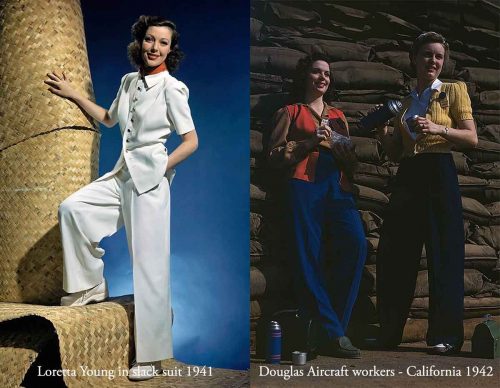
Women now regularly wore trousers or ‘slacks’, again popularised by Hollywood stars such as Marlene Dietrich, Katherine Hepburn and Carole Lombard.
Military fashion following the US entry in the war, was considerably more glamorous than its European counterparts. The Women’s Army Corps (WAC), the Navy’s Women Accepted for Volunteer Emergency Services (WAVES), the United States Coast Guard Women’s Reserve (SPARs). Women Airforce Service Pilots (WASPs), United Service Organisations (USO) and their glamorous recruiting posters, all epitomise a fashion era that is uniquely American and very non-French.
In particular, the two Navy auxiliary units – the WAVES and the SPARS were the envy of all; they had their very own New York couturier – Mainsbocher !
For anyone interested in American women in service in WW2, their fashions, uniforms, hairstyles, lifestyles and so much more, you can now download direct to your device 1940s US Wartime Womens Guides. Rare restored handbooks, sewing guides, magazines, beauty and hairstyle advice.
The leading light by a long way in American fashion in the early 1940s was Claire McCardell. In 1943, her utility themed pop-over dress at just $6.95 sold in the thousands. In Claire McCardells designs, a woman went to work smart!
Parisian Haute Couture however did quietly make advances …during the war years, with 19th century lines increasingly taking hold. As a result, by the end of the war, as Allied troops marched into the city they were greeted by excited women sporting a whole new silhouette.
Gone was the boxy military lines – waists and shoulders had narrowed and hips had widened, and when Christian Dior produced his Corolle Collection in 1947, dubbed The New Look, all eyes had turned to Paris once again.
The Cheongsam dress
One piece of Asian dress to make an impact in Hollywood fashion during the 1940’s thanks to actresses like Yoshiko Yamaguchi and Li Li-Hua was the Chinese Cheongsam, a tight fitting adaptation of the traditional Qipao which materialised during the 1920’s and unlike the shapeless shift dresses of the flapper, hugged the curves of the body. In China this dress was hugely popular throughout the Republican era of the 1930’s and on into the 1940’s.
3.Daywear
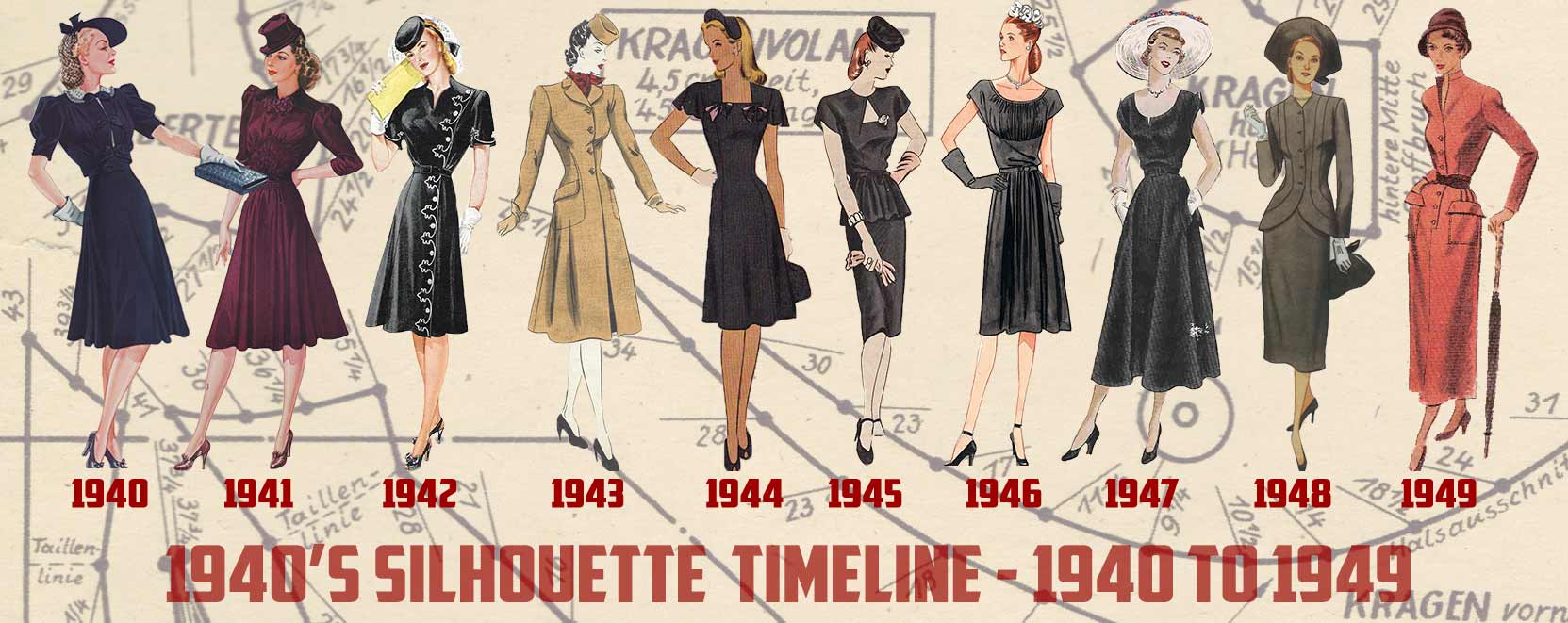
With a distinct war era and post war look (discussed later), women’s day-wear in the 1940s is defined by its silhouette.
The war era suit, with its tailored look, nipped in waist and boxy shoulders was worn with short bolero jackets for formal, and cardigans and jackets to just below the waist for informal. Hips were given attention by wearing tunics and by 1944 peplums became a regular feature which heralded more shapely times to come.
Skirts had less pleats and hems were high – just to below the knee and the simple shirtwaist dress echoed the freedom of the 1920’s. The military influence was evident with belts and collars and an overall mannish feel to the ensemble.
In England, women were encouraged to wear the utility dress and many had joined the forces and were mostly seen in uniform.
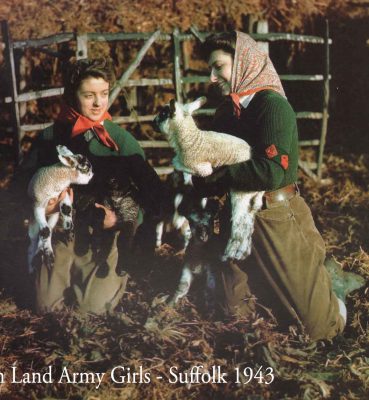
The Womens Land Army took over the farms of the nation during the war years and by many accounts did a vastly superior job
In the countryside, the Women’s Land Army ( formed during the 1914-18 war) fondly remembered as the Land Girls, with their heavy overalls, woollen sweaters and headscarves were a common sight astride haystacks and at the wheels of tractors.
In America, the various women’s reserves, with their considerably more glamorous uniforms helped galvanise a new industry. Everyday women adopted the growing popularity of sports wear and understated separates.
The ever popular shirtwaist dress was reworked using utilitarian fabrics and the wearing of trousers with woollen sweaters and cardigans was now a quite acceptable and respectable mode for day wear.
Though the Paris silhouette had changed to a more classical feminine silhouette by the end of the war, with peplums and draping on most outfits, it wasn’t until 1947 that Christian Dior’s Corolle line, dubbed as ‘the New Look‘ moved the line back to more feminine curves. American designers like Adrian initially hated the frau frau of post war Paris, and few women had the figure to adopt it, but by the end of the decade, Paris was back on everyone’s radar again.
4. Eveningwear
By 1939, Paris evening-wear was taking on a distinct 19th century tone again with corseted waists and full skirts. The outbreak of war however put paid to this frivolity in anywhere but wealthier class circles and in of course Hollywood movie-land. During the war, for the average woman, formal evening dresses were abandoned due to strict austerity measures and the silhouette remained boxy.
It was acceptable to wear the same dress on a Friday or Saturday evening, if going out after work. The work suit could be glamorised by a pretty hat or a fur collar, and of course the ever important red lipstick.
After liberation the Paris couture houses who had continued to cater for wealthy clients during Nazi occupation, had to tone down their lines for exporting to countries where austerity measures were in place.

In Paris, while the fuller and longer skirts with side bows, peplums, back yokes and waist cinchers were being studiously designed, it was considered to be somewhat of a revelation to the rest of the world in the post war years. The New Look for evening dress led by Parisian couturier Christian Dior returned to opulence!
5.Outerwear
1940s outerwear screamed “masculinity”, with coats sporting hoods and deep pockets, inspired by Schiaparellis ‘cash and carry’ line of 1939.
Broad shoulders and mannish lines were the order of the day; the gabardine raincoat, belted single breasted coats and double breasted coats. Capes were common for both girls and older women and in America, sporty ski jackets were a favourite. Sears catalogue was full of imitation furs which feminised the more mannish coat styles.
The aforementioned belted gabardine trench coats with their military mannish silhouette were very much in vogue as a winter coat on both sides of the Atlantic, as well as faux furs which helped add a little pre-war glamour to otherwise utilitarian suits.
6.Underwear
The standard set of undergarments when wearing a dress comprised a brassiere and pantie girdle, worn under a slip. Women in uniform were advised to limit their underwear to a simple pair of directoire knickers and vest made from fine wool. With the make do and mend edict in full swing, women would often hand knit their own.
Many women cherished a good corselette if they had a slim figure. It helped a uniform sit better with easy fasteners for stockings. That being said, as many women wore trousers for large parts of the day, often doing heavy manual work, so less restrictive underwear was preferable.
Most young women possessed a good pull-on pantie girdle which could be worn with skirt or pants. A simple slip was generally worn over bra and panties and you were good to go.
7.Accessories
The 1940’s woman made an art of accessorising, in particular with hats and gloves. Author Grace Morton declared that “wearing hats is our method of singing in the dark!” Bags were large and functional and as useful as the larger pockets in coats.With zips unavailable, the draw-string bag was the alternative. Leather shoes were hard to come by but thanks to the innovations of the likes of Italian designer Salvatore Ferragamo, there were many alternatives from reptile skins to straw!
Hosiery
Many women saved their precious nylons by resorting to woolens or in the warmer months, cosmetic leg paint – liquid stockings, of which there were many varieties available.With the increasing austerity of war in Europe however, many had to resort to mixtures made from tea, cocoa or gravy.
Once the legs were painted, the seams were painstakingly drawn up the back of the calf. For younger women, the alternative was to simply wear ankle socks. In the USA, women handed in their used stockings for use in war production, and various cotton stockings were back on the market once more with coloured prints and meshes offering novelty in a time of restrictions.
During 1946 there was literally a run on stockings across the world when nylons became available again, with large queues outside department stores. Nylons were back with a bang and women the world over snapped them up.
Shoes
The most severe restrictions during WW11 applied to footwear. Leather was to be exclusively used for military boots – no exception.
Though high fashion shoes, for those who could afford them, in the 1940s, were extremely stylish and in leathers of various kinds, for many women, wooden,synthetic cork soled shoes were a reality, and in general, shoes in the 1940s were plainer and designed for long term use. Most women would have one of at least three types of shoe: Oxfords, Pumps and Sandals.
Oxfords came in service type with round toes and leather heel; Dress Tie with a Cuban heel; and Two eyelet with square toe and leather heel.
Pumps came in Kidskin with Cuban heel; Calfskin with wedge heel; and for the lucky – patent leather with a high continental heel.
Sandals came in fabric upper with a pyramid heel; Calfskin with wedge heels; and Sling type with French heel.
In America, peep-toes were popular and satin mules were a must for the boudoir. After the war, with the advent of the New Look, massive platforms and wedges were out and replaced with daintier narrow pumps again, slingbacks and sandals.
Above are some beautiful examples of popular shoes form the 1940’s by the excellent Moscow based site Shoe Icons. It’s a treasure trove for shoe lovers.
If you’re fed up trawling through thrift stores for vintage women shoes from the 1940s, then try Royal Vintage Shoes for beautiful bespoke vintage style shoes from the 1940s like these pictured below.
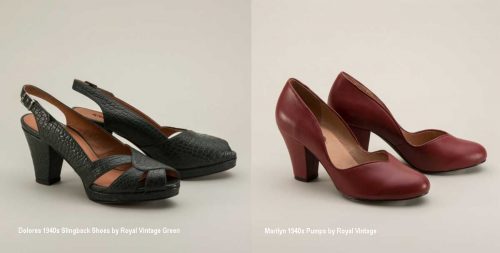
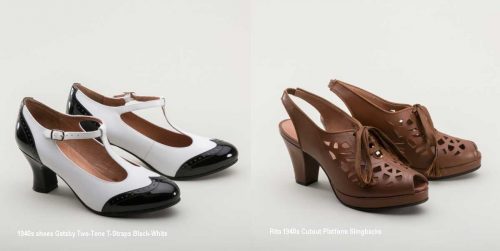
Hats
“Wear it at a jaunty angle” was the advice, no matter what your choice of hat, and there were many. The advent of up-do hairstyles and in particular pompadours, hats one could pin such as the pillbox became more and more a la mode. Adding a certain mystique to a woman’s hat and face were the addition of hat veils and were extremely popular again since the mid 1930’s. Modelled above by Gabriella D on Instagram@nancy_wake.
Hats were not rationed, but expensive and many women considered the pillbox a tad frivolous, and chose to wrap their hair rolls in snoods, ( made popular by Vivien Leigh in Gone with the Wind ) turbans and head-scarves instead. These were more practical and safe when working in factories or farms.
The 1940s Turban or Headscarf epitomises the war era woman, and was worn as a simple solution to long hair by the Land Girls or factory workers. And of course it adorns the many iconic images of Rosie the Riveter.
The 1940s beret briefly was ‘a la mode’ thanks to General Montgomery, whose successes with the Desert Rats in North Africa, made him a war celebrity.
In America crocheted skull caps by milliner Sally Victor made it to the cover of Vogue magazine in 1944.As in the 1920s, hairstyles and hats dictated to each other what the next mode was to be, and by the end of the decade, with cropped hair and shingles back in again, hat styles obliged with cloche styles and wide berets.
Swimwear
Despite it’s shortage during the war, DuPonts Nylon became the worlds first ‘celebrity” fabric.Hollywood movies pushed the boat out with a raft of new starlets in figures to die for. 1940’s Swimwear adapted to this new pin-up figure of small waists and pert breasts.
These new look ‘Esther Williams inspired’ swimsuits were not available to the public until after the war and Nylon was freed from conscription.
Nevertheless, swimwear designers side stepped fabric restrictions and produced the ‘two-piece’ and began to redesign swimsuits to fit the Hollywood ideal. With Lastex out of the picture, they introduced boning and cinching, and with pin-up stars like Betty Grable, Ava Gardner and Rita Hayworth, the 1940’s saw a huge leap in swimwear styles.
Notable designers included Tina Leser, Claire McArdell and Carolyn Schnurer. The most notable item of swimwear of the 1940s was the bikini, launched in 1946 by French designer Louis Rèard, and named after the infamous US Atom bomb test on the Island of Bikini, the indigenous occupants of which had been forcibly removed.
Makeup and War
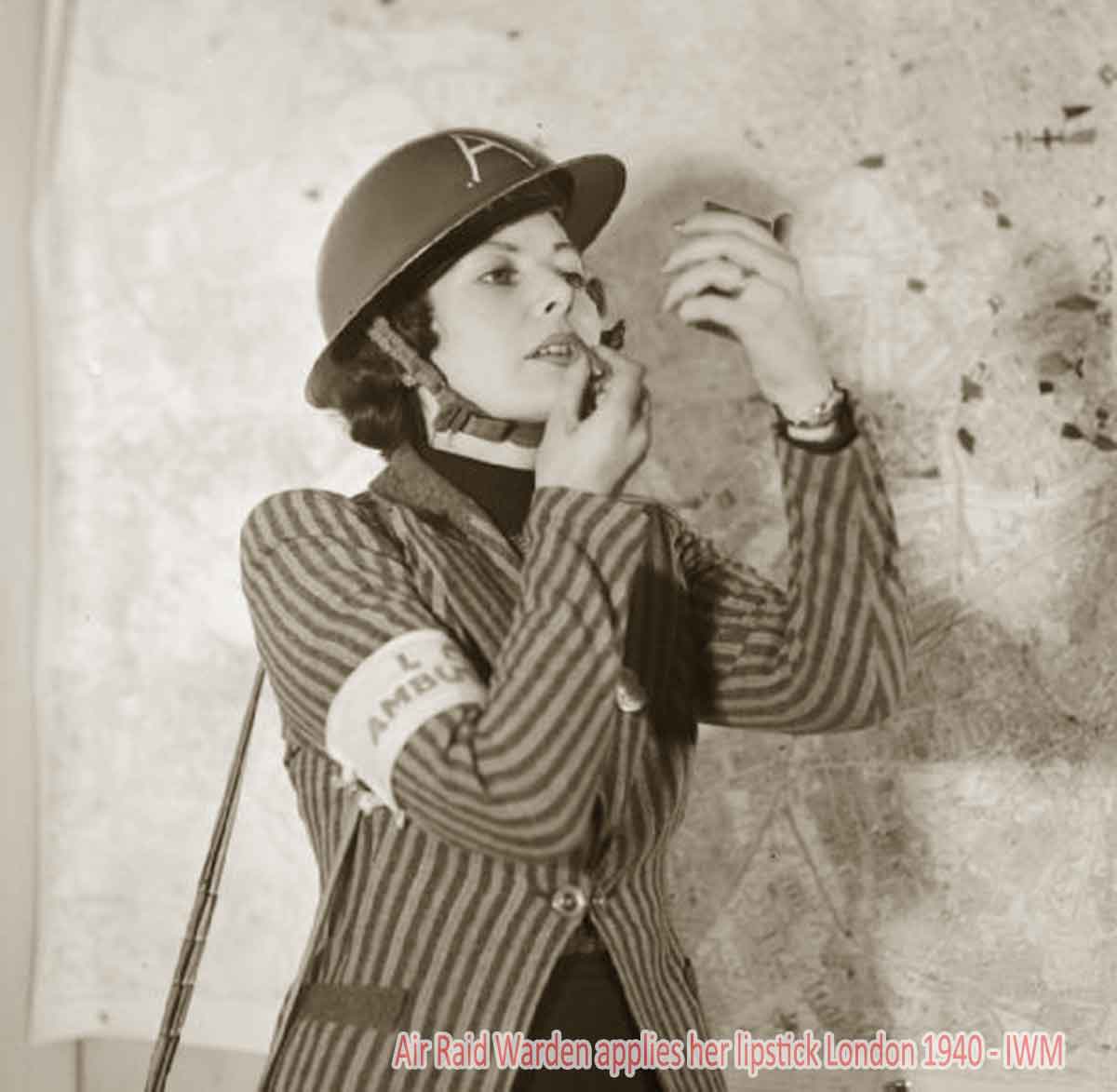
Make-up in wartime, was important to moral, and in particular to a woman’s moral. US Army Nurse Corp nurse Ruth Haskell in her entertaining memoir Helmets and Lipstick ( available free on the Internet Archive) described a particularly poignant Christmas in 1942 when she was stationed in Algeria. ” A friend of mine who knew me rather well sent me two beautiful lipsticks, and I did welcome them! As I had once told my C.O, if ever I should stop using make-up there would be nothing left of my morale!”
The reality for many women in Europe, during and after the war, was that a trusty lipstick and powder compact was about the height of luxury that a girl could expect and pair of vivacious red lips was her statement of defiance and courage.
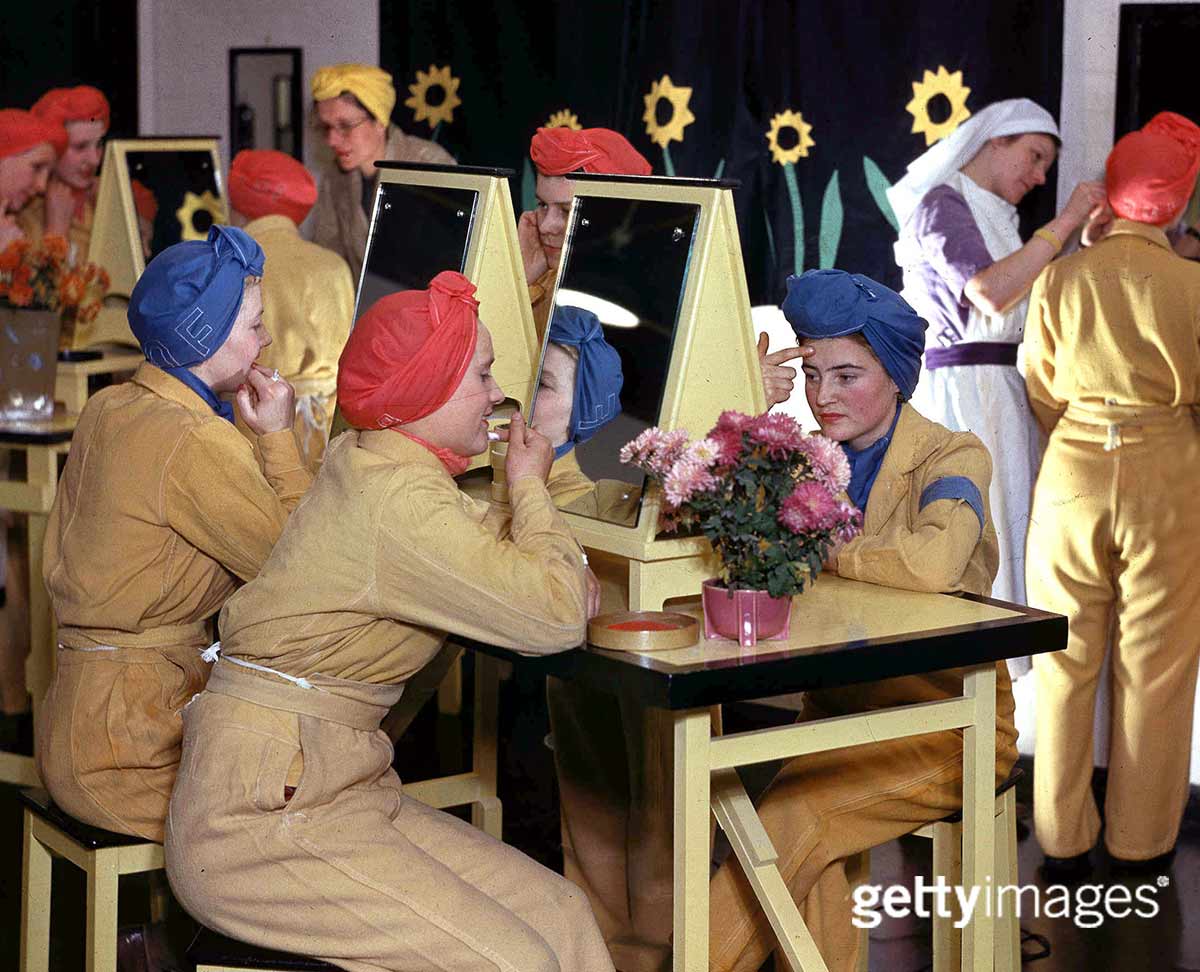
Royal Ordnance Factory workers attending a make-up station in 1943, to apply protective face creams before work ®Getty Images
For women working in munitions factories, the phenomenon of skin yellowing from working with toxic chemicals daily, called for women to use heavy creams to shield their skin. In the USA, Max Factor regularly sent free supplies of make-up to factory workers which certainly boosted morale.
8.1940s Hairstyles – Pomps and Updos
In general hairstyles in the early 1940’s moved toward up-dos, with hair off the collar. In particular, the increased demand for women in manual labour, and the shortage of hair products meant that women covered and tied up their hair in turbans and snoods when working. For the everyday woman hair was generally shoulder length and cut in many layers to enable easy styling.
Parting was usually to the side and styling elements consisted of soft waves, curls and rolls. The Victory Roll became a popular choice in the USA. Pompadours grew in popularity too during the war, involving lots of back-combing and hair rats. Accessories included bobby pins, combs and grips.
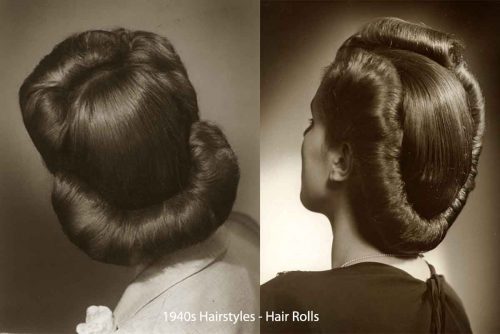
This bouffant and roll style of hair in the 1940’s was accented by smaller more ornamental hats – in particular the pillbox. By 1946 however, the pompadour faded quite rapidly in popularity and flatter hair with a variety of side partings was back in.
The New Look from Paris finished off the decade in 1949 with a whole new silhouette yet again – the sheath and the shingle. Boyish haircuts were back !
9. Diors Post War Silhouette
In 1945 and 1946, a travelling exhibition of miniature wire framed dolls from Paris called Theatre de la Mode, quickly asserted that Paris was on the rise again.The exhibition was the brain child of Robert Ricci, son of designer Maria Nina Ricci and featured fresh new designs from 40 Paris couturiers, including young guns Cristobal Balenciaga, Jacques Fath and Pierre Balmain. The dolls themselves were designed by Elaine Bonabel and realised by sculptor Jean Saint-Martin .
The collection, believed lost for many years, can now be seen in all their restored glory at the MaryHill Museum of Art in Washington. Amongst the dolls was one particular polka dot dress from Lucien Lelong and it is almost certain this dress was by Christian Dior who still worked for Lelong.
The New Look 1947
In the early months of 1947, on the 12th February to be precise, a 42 year old Christian Dior astounded the fashion world with ninety silhouettes comprised in two lines: En Huit and Corolle.
It was an uncompromising change of silhouette. Harpers Bazaar editor Carmel Snow was overheard by a Reuters correspondent to exclaim to Dior afterwards “It’s quite a revolution, dear Christian, your dresses have a totally new look!” The story goes that she seized the slogan, scribbled it on a note and threw it to a courier who posted it to the US that very day.
The newness of the dresses, in particular Diors soon to be iconic bar suit was reported in US papers before they appeared in France. Shoulders were narrow, waists were nipped using a waspie and skirts were enormous in their fullness. The ‘bar suit’ was featured in Vogue and represented a new year zero in fashion.
Even in war ravaged Warsaw, which faced many years of austerity ahead, fashion shows doubling as charity events began to appear, with tantalising designs, if not fresh off the Paris runways, certainly with a breath of fresh air. Polish designer Jadwiga Grabowska opened a new fashion house “Phoenix” and became a significant figure in Polish fashion during the communist era.
The Bar Suit Photograph Misconception
The famous “New Look” photograph of Dior’s bar suit was immortalised, according to fashion historian Jonathan Walford – not in 1947, but in 1957 by model Renée Breton in a photo taken by Willy Maywald (right).This suit was an updated version made by Dior in 1955 for a lecture tour. “I hate this image,” declares Walford. It has a notched collar, instead of the original shawl collar from 1947, and flares out at the waist similar to the suit displayed at the V&A museum. The original bar suit by Dior was photographed for Vogue magazine April 1947 edition by Serge Balkin.( note the jacket has Six buttons – not five ). This is displayed by the Met Museum. Walford also notes that in the Maywald photo, the shoes worn by Breton were captured in another photo taken in 1957. I love a good detective story!
With the fuller silhouette and lower hems, there was perhaps nothing entirely new in this ‘new look’. It harked directly back to the Romantic eras.
Paris’s radical shift away from the austere linear silhouettes of the war years, made it impossible to ignore, and despite some furrowed brows and protests from American designers like Gilbert Adrian, the New Look was to develop in several ways, into two distinct silhouettes by the early 1950s, the gamine and the circular. British designers like Edward Molyneux and Hardy Amies enthusiastically embraced the new romantic styles, adding nipped waists and softer lines to his first post war designs.
By 1949, the fashion silhouette had changed dramatically in the USA, signalling finally an end to the so-called post war era. Gone were the military boxy suits, and with it a hope for a new era in peace, prosperity and of course – femininity.
That’s all !
© 26/10/2016 Stevie McGlinchey Glamourdaze.com
Source Reading:
Fashion Since 1900 – Valerie Mendez / Amy de la Haye
1940s Fashion Source book – Emmanuelle Dirix & Charlotte Fiell
Further Reading:
Betty H. Carter Women Veterans Historical Project
Shoe Icons
A Concise Illustrated History of Fashion – 1900 to 1919
A Concise Illustrated History of Fashion – 1920 to 1929
The History of 1940’s Make-up
